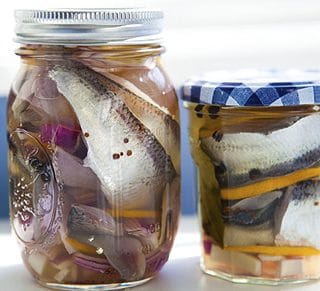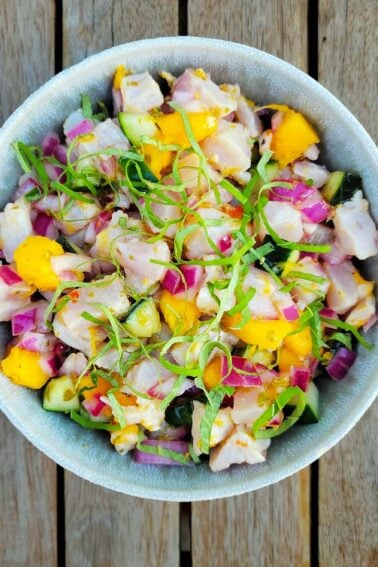As an Amazon Associate I earn from qualifying purchases.

Herring spoils so fast it is almost always eaten salted, pickled or smoked. I’ve eaten (and made) herring in all these forms, but there is something special that makes pickled herring so popular, especially in Northern Europe.
I think it’s because the acidic twang of the vinegar and lemon counteract the rich fattiness of the herring fillets — these fish are among the foods highest in healthy omega-3 fatty acids. The addition of spices, sugar and onion add a personal touch.
This particular recipe is for Swedish glasmastarsill, or glassblower’s herring. Why it is called that I have no idea. Best I can tell it is because this pickle is always put up in glass jars, with the silvery skin of the herring facing outward. Let’s face it, folks: For a pickled little bony fish, this is as pretty as it gets.
Most pickled herring recipes start with pre-salted herring — the kind that come in cans. If you use these, skip the salt in the initial brine and soak the fish in fresh water overnight. They’ll still be plenty salty.
Having some salt in the fish is important: I once made this recipe with fresh herring that I failed to brine, and they turned to mush within 2 weeks. A disaster. You need the salt to extract extra moisture from the fish and keep them firm.
I like these just as a snack, with pumpernickel or rye bread, potatoes of any kind, hard-boiled eggs — or just on a cracker.
If you are so inclined, here is a good primer on food safety when pickling fish, from the University of Minnesota.
Swedish Pickled Herring
Ingredients
- 1/4 cup kosher salt
- 5 cups water, divided
- 1 pound herring fillets
- 2 cups distilled or white wine vinegar
- 1/4 cup sugar
- 1 teaspoon mustard seed
- 2 teaspoons whole allspice
- 2 teaspoons black peppercorns
- 3 bay leaves
- 3 cloves
- 1 lemon, thinly sliced
- 1 medium red onion thinly sliced
Instructions
- Heat 4 cups of water enough to dissolve salt. Let this brine cool to room temperature. When it does, submerge the herring fillets in the brine and refrigerate overnight, or up to 24 hours. Meanwhile, bring the sugar, vinegar, the remaining cup of water and all the spices to a boil. Simmer 5 minutes, then turn off the heat and let this steep until cool.
- When the herring have brined, layer them in a glass jar with the sliced lemon and red onion. Divide the spices between your containers if you are using more than one. Pour over the cooled pickling liquid and seal the jars. Wait at least a day before eating. Store in the fridge for up to 1 month.
Nutrition
Nutrition information is automatically calculated, so should only be used as an approximation.





“Attikssprit” is 10% acetic acid vinegar; I have never seen it for sale in the US, even in Minnesota or the Dakotas. Though I wasn’t looking for it either.
The same effect should be possible by reducing the amount of water used, and increasing the amount of ordinary (5%) vinegar used.
I have used Hank’s Swedish pickled herring recipe, it turns out great! I opt to use a bit less sugar, but my family prefers it exactly how it is in the recipe.
Thanks for the answers! Joseph- I’ve had the canned kippers before and whatever it was I had in the restaurant was a far cry from those. The canned kippers I’ve had were definitely of a hot smoked flakey kind of texture and the herring in the restaurant was like a cross between pickled and cold smoked fish. Very tasty 🙂
I’d love to hear about that shad recipe. I read somewhere that an Indian story told of how a porcupine- being either punished or hidden- was turned inside out and placed in the rivers and sea. Thus, the shad was born!
The pickling process dissolves the fine bones of the herring. pickling will soften the back bone but not dissolve it. The stronger the vinegar concentration the more the bones soften or dissolve.
The smoked herring you had was likely kippered herring. a process that dissolves the bones as well.
There is also a very slow baking technique for shad that could be used for herring, the process dissolves the shad bones. Shad are a larger cousin of herring.
Does this process make the bones dissolve? I smoked some herring we caught last year and they were delicious but a ton of tiny bones. I never remember finding bones in pickled herring though…was wondering if fthe vinegar dissolved them.
Also do the jars have to be sealed with the boiling method or are you just screwing the lid shut?
Last question- I’ve had smoked herring in restaurants that had no bones…were these maybe pickled first then smoked? I really hate bones…can ya tell?
Thanks!!
Liz: It softens the bones so you can barely notice them. And yes, I just crew the lids on and keep the fish in the fridge. No idea about smoked herring with no bones…
I don’t use white sugar at all. I keep bees so honey is my main sweetener and I occasionally use blackstrap molasses or brown sugar depending on the recipe. I noticed a comment about omitting the sugar, could honey be used as a substitute? How about a milder vinegar maybe. I have homemade persimmon vinegar which might be better without the sugar. I will probably try it with sardines since they’re easy to come by where I live. Any advice would be appreciated.
Caroline: You’ll have to experiment on your own. No idea. Let me know how it goes, OK?
can one substitute sardines or mackerel?
Steve B: Yep.
Can the sugar be left out of this recipe?
Tasha: I think so.
Caught a lot of herring about a week ago in the Long Island sound (great fishing). I had them in brine for a day then put them in the pickling solution . How long should I wait before eating and how long will they last?
Bill: Thought I covered that in the recipe. You want to wait at least a couple days, and they will keep a couple weeks in the fridge.
Thanks, Hank- Into the jars they go!
I just caught a bunch of herring from the Long Island Sound and have the fillets in brine as per your recipe. Do you brine and pickle fresh fillets? I’ve seen a few warnings about needing to freeze or cook the fillets to kill any parasites. What are your thoughts? Are these warnings only for freshwater fish?
Darren: Saltwater herring are not parasitized, to my knowledge. Besides, the salt and vinegar will do a job on anything.
GREAT blog! Now, SILL (herring). Commonly, we use ready-brined sill. It should be really salty, so it has to be rinsed for a few hours (or change to fresh water every half hour). Taste the fish. It should be salty, but edible. Then, put it the brine, which is made of 3 parts water, 2 parts sugar and 1 part attika (see below). This sits for two days in the fridge. Now you can make the actual sill. It’s the acidity and the salt that makes it able to store, but the traditional swedish herring is also quite sweet. We use something called “attika” or “attikssprit” instead of vinegar. This is sort of a vinegar on really illegal steroids. There are two common brands: Winborgs and Perstorp. If you live in a big city (or in Minnesota) you could probably find this in the US. This is kinda important if you want the geniune swedish taste!
The classical swedish flavourings include: yellow or red unions, horseradish, leeks, bayleaf, allspice, mustard seeds, dill, whole pepper, carrots and cloves. There are no rules. We are not italians here. There has actually been some crazy sill variations seen on christmas tables the last ten years. Asian style, with cilantro, lime and chili. Vanilla, BBQ-sauce, pesto and mango are all experiments that should have stayed on the idea stage… My personal favorites include all sorts of “creamy” sill. These will store only for a day or two in the fridge – but you probably won’t have to. For example: acidic red apple, plenty-o-fresh-grated-horseradish, chives and sourcream. Or caviar, creme fraiche, chopped red union and dill!
One well hidden secret is the matjessill. Originally dutch, it is now a very common sill on the swedish midsummer. If you find it, try this recipe and nothing else. You will die and go to heaven: Matjessill, hard boiled eggs, finely chopped red onion, fresh dill, and the most important: plenty of well browned butter on top. Serve with fresh potatoes. Aaahh.
Good luck 🙂
Pete: Thanks for all that info!
Thanks for the recipe! Looks delish! I featured it on my blog: https://www.colorfulcanary.com/2015/07/15-enticing-capelin-small-fish-recipes.html
Just caught some herring at Richmond Point with my son. Sabikis were the ticket. Half the catch went to these pickles, half to the smoker following your recipe in the book. Great eats! Thanks!!
This recipe is great! I live in Sweden and it was right on for my guests at Midsummer. I also made a special fusion flavor for herring for Jul (Christmas) it’s a spicy Korean Kimchee herring… really good! I make a video for it… you can find that and the recipe on my blog here: https://www.americulinariska.com/2014/12/11/pickled-herring/
To Ken Albala – You can probably catch Jack Smelt from a pier in Stockton, they are very like herring and bite well on raw shrimp or bacon. Fishing from a pier in Bodega Bay, CA, two people brought in 27 fish between a foot and 18″ long, in one morning. Pickled with onion and lemon per the Glasmastersil recipe, they filled 10 quart mason jars with tasty beauty! I tasted them on day two and found them edible but the bones had not yet dissolved. We cut up our Jack Smelt into quarter inch thick steaks. The Fish and Game website says pickling does not kill roundworms, so microwave the fish on high for two minutes and let them cool before serving them.
Leave out half the sugar in this recipe for a more savory fish.
If you have a garden, put the heads, tails, and guts in a covered bucket with water and let it decay into liquid fish. Dilute this heavily with more water before using it on your garden. Corn and pumpkins prosper with some of this fertilizer a couple of times a month through the summer.
While fishing, I saw a big halibut chasing the small smelt. You might want to bring two rods, one for smelt and one with a halibut rig, if you go fishing for your pickling fish.
Do you have to wash the brine off the herring when you brine it yourself, as stated in the recipe?
Great recipe we have large schools of mackerel off the Farne Island’s Caught 50-60 this week after friends had some Marinaded the rest delicious
Hi Hank,
Wonderful recipe, but I’d like to store without the expense of refrigeration.
Can you recommend a reliable source of canning information for pickled herring?
Used above recipe with Aussie Herring (West Australia) – also known as Tommy Rough in Eastern States. Comes out well. Yum on a good dark rye bread with beer (Aussie of course!)